1
Early Days of CKNX1924 - Doc was selling Stromberg Carlson radios in his down-town shop by night and on weekends. In those days (about 1924) there was only four or five radio stations in Canada and this new technology was really only beginning to catch the imagination of listeners in the U.S. Radio sales were few and far between but interest was building. But Doc persevered and quit his job at the foundry and opened his store and radio shop on Wingham's main street. Sales picked up and it was then that he got the idea that perhaps he could contribute to the rather sparse choice of programming material that was being broadcast at that time. (Carbert essay, 1995)p.1-2
Feb 1926 - "Radios were a luxury in February 1926, and it could take some pursuasion to convince someone to buy one. It wasn't the kind of weather to try that persuasion. ůSo the young man, the only radio retailer and service man in a 50 mile radius, sat in the rear of his little shop on Main street in Wingham and idly examined a copy of Popular Mechanics magazine. He came across a story on how to build a simple radio transmitter, and decided to give a try. He had all the needed parts around the shop and within an hour had put the thing together. A telephone mouthpiece was utilized for a microphone and some storage batteries provided the power. (VS-1, 1976)
The young man didn't even know the set worked until tinkering with it a day or two later he had a telephone call from a citizen to whom he had earlier sold a radio set to say that the signal was coming in fine. Almost by accident Wilford Thomas "Doc" Cruickshank had stumbled onto the career that was to make him a legend in western Ontario and in the Canadian broadcasting industry. That day, February 20, 1926 became the beginning of ...CKNX radio and later lead to CKNX television." (50 years, 1976, p.5) (VS-1, 1976)
2
W.T. "Doc" Cruickshank with the radio transmitter he built with a Popular Mechanics articleFebruary 1926
Cruickshank's Radio Shop, Josephine Street, Wingham, Ontario
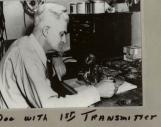 Credits:
Credits:North Huron Museum, Wingham, Ontario
3
A radio from the Doc Cruickshank collection-an example of what he sold in his store.1930-1940
Cruickshank's Radio Shop, Josephine Street, Wingham, Ontario
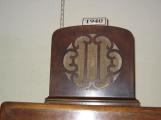 Credits:
Credits:North Huron Museum, Wingham, Ontario
4
Doc's story in his words in "Voice of the Pioneer," by Bill McNeil (ISBN 0-7705-1730-7"One tube was all I had in this transmitter, yet it was heard nearly all around the world. At other times it couldn't be heard fifteen miles outside of town. The trouble was that even though I had a transmitter to send sounds out from, nobody had receivers to pick those sounds up on. There were no receivers, in other words, radios, available so I had to make them myself if I was going to sell them. The first three or four I made I was able to sell in just a few minutes, and that gave me the idea - why don't I represent some firm that manufactures radios? So I got a company in Hamilton that was making them to supply me with these receivers and I went out and sold them myself for one hour a day. That's where I actually got it started.
Actually I could have sold a lot more of these things if I had the time, but I didn't. I just had this one free hour a day. You see, I worked in the foundry ten hours a day, seven days a week. And I ran the projector in the picture show for about fours a night. There was one hour left over between seven and eight o'clock in the evening where I had nothing to do. That's when I sold radios.
Nobody worried too much about studios in those days. Just about any place at all would do to put on a program. On Sunday we always did a service from one of all the churches. At that time it meant that we had to connect up all the churches in town with a telephone line. We brought a great lot of wire and strung it on top of buildings and everything else, from the studio over to one of the churches. We did that for years before anyone thought there was any other way of doing it.
On Sunday, after church service, we had a little program for which I took the transmitter and everything down to my home. I had to do that in order to get a piano. I'd carry the transmitter under my arm down to my home and we'd do an hour broadcast, Sunday afternoon, from down there. There was a program of music-hymns and that sort of thing-with local people along for singing and playing the piano. There was recorded music available but it was of no use to me because I didn't have a turntable to play it on. I only had one microphone, and everything was done through that.
We didn't even know that you had to have a licence for broadcasting. Somebody tipped me off that I had to have one and, by golly, I enquired around and sure enough, I was supposed to have a licence. It was very simple to get it, though. All I did was write a letter and pay ten dollars. Before all this business of the licence I was calling the station J-O-K-E, because that's all it was to me up to this time, a private little joke and a lot of fun. But you know, depending on atmospheric conditions, that little station with one tube was being heard, some nights, all around the world. Of course, that was before the airwaves were all cluttered up with hundreds of thousands of stations. When you get a good night, why, my goodness, the world wasn't big enough for you. Lots of other nights, though, we couldn't even get outside of town.
5
Story of how Dr. Howson worked with Doc Cruickshank to start the Wingham Radio Club1924-1940
Wingham, Ontario
 Credits:
Credits:Wingham Library, Wingham, Ontario
Wingham Professional Businesswomen's Association
6
Dr. George Howson helped organize the Wingham Radio Club.1924-1940
Wingham, Ontario
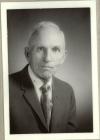 Credits:
Credits:Wingham Library, Wingham, Ontario
Wingham Professional Businesswomen's Association
7
Dr. Hamilton, one of CKNX radio station's first sponsors in 19361936
Wingham, Ontario
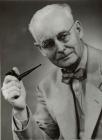 Credits:
Credits:Wingham Library, Wingham, Ontario
Wingham Professional Businesswomen's Association
8
Description of Dr. Hamilton's involvement in early CKNX1936
Wingham, Ontario
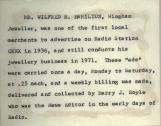 Credits:
Credits:Wingham Library, Wingham, Ontario
Wingham Professional Businesswomen's Association
9
W.A. Galbraith served as treasurer of the Wingham Radio Club in 1926.1926
Original radio station, Josephine Street, Wingham, Ontario
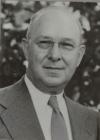 Credits:
Credits:Wingham Library, Wingham, Ontario
Wingham Professional Businesswomen's Association
10
W.A. Galbraith's 1930 Wingham Radio Club card1930
10 BP station, Wingham, Ontario
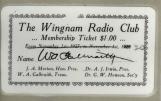 Credits:
Credits:Wingham Library, Wingham, Ontario
Wingham Professional Businesswomen's Association
11
W.A. Galbraith's column on radio included information on other radio stations' programming.1920-1940
Wingham, Ontario
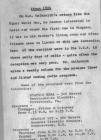 Credits:
Credits:North Huron Museum, Wingham, Ontario
Wingham Professional Businesswomen's Association
12
The Other Story ....As in many small towns, there is often a story behind a story. Over the years, the story of Doc and the Popular Mechanics article appeared in most newspaper, magazine, radio and television stories on W.T. "Doc" Cruickshank and CKNX. But there is an element to it that was forgotten. In the early days, radio enthusiasts shared their knowledge and equipment, much the same way internet geniuses share programs and tips, not to mention computer viruses.
In a little town, about a half hour closer to Lake Huron than Wingham, another radio pioneer was also experimenting with the new media. His name was Melville Culbert. He, too, built a radio transmitter. He, too, decided to add to the radio programming (or lack thereof) of the area. He broadcast musical shows out of the living room of his parents' house as well as the back room of the Dungannon general store, often featuring the vocal talents of his sisters, the Culbert Sisters.
Culbert learned he needed a radio license. When this media was young, the government decided tight control was necessary. Those transmitting programs needed a license and had rules under which they could broadcast, much like today. They were awarded licenses and given limits to which they could expand their transmitting powers, given a certain place on the radio dial and designated as amateur or professional. The designation controled who could charge for on-air radio sponsors and ads.The government also limited the number of licenses they gave out in any one area. As radio became more popular, the application for licenses became a very competitive process.
Culbert applied and received an amateur license, allowing him to broadcast under the call letters 10BP around 1924. This amateur license obtained from the Canadian Department of Transport, allotted Culbert 1200 kilocycles on the wave band, with a power of 10 watts and a set of call letters 10BP. (25th CKNX Anniv., 1951). The license did not allow for the sale of advertising. When Doc found out he needed a license, he applied but was denied due to the proximity of Culbert's broadcasting. He and Culbert came up with a unique solution. They shared the license (unofficially) as well as a vacuum tube, which they drove back and forth to each other. Cruickshank broadcast on Tuesday and Thursday nights while Culbert broadcast on Sundays and one other day of the week. Culbert and Cruickshank relied on local men and women to sing and play instruments on their radio shows. Mel Culbert's Dungannon show regularly featured Stuart Plunkett on violin with Les Schultz and Tom McLean singing. Gertie Kating of Goderich was a solo vocalist who appeared on Culbert's show as well as Cruickshank's Wingham broadcasts. The Wingham show also featured the popular Culbert sisters singing duets.(Dawson essay)
On-Air Profanity ...
During one of the Dungannon broadcasts, Culbert committed one of the first on-air uses of profanity. As the emcee, Culbert introduced all of the acts and did all of the commentary. After a performance by a local singing group, Culbert, forgetting that the microphone was still live turned to the waiting performers and asked," Well, what the hell are we playing next?" This created quite a controversy at the time and spawned several editorials in the local newspaper regarding the use of profanity on the air.(Dawson essay)
More Power ....
Cruickshank and Culbert enhanced their power by enlisting the expertise of James Johnson from Goderich to aid in the design of the transmission antenna. Johnson had recently completed installation of the rural telephone system in the area and had a superb understanding of what would be needed to construct a wireless transmitter. Johnson also tweaked Culbert's radio design by adding a large horn-shaped speaker so that more than one person could enjoy radio transmissions at a time. With a small transmission tower in place in Dungannon, Cruickshank then set out to build one in Wingham as well. (Dawson essay)
When both Culbert and Cruickshank asked their listeners to tell them where they heard their signal, they were surprised by the distances their signals travelled. When Culbert learned that he was being heard approximately 75 miles away, which was quite good considering the equipment that was being used near the end of 1920s, he decided it was time for more power. He replaced his six-volt batteries with automobile batteries. In doing so, he melted down his entire broadcasting system. (Dawson essay) At the time he was also ailing from tuberculosis. Lacking the energy to rebuild his entire set, he gave up his license to 10BP. Doc, then applied for a license of his own - he obtained a professional license and a new set of call letters - CKNX.
When Mel Culbert got sick with
13
Melville Culbert, who shared the 10 BP license with W.T. Cruickshank.1924-1930
Dungannon, Ontario
 Credits:
Credits:Mrs. Len Crawford, Wingham, Ontario
North Huron Museum, Wingham, Ontario
14
Culbert's parent's house in Dungannon, Ont. where he broadcast his programs under 10 BP1920s
Dungannon, Ontario
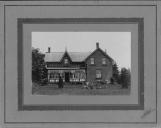 Credits:
Credits:Mrs. Len Crawford, Wingham, Ontario
North Huron Museum, Wingham, Ontario